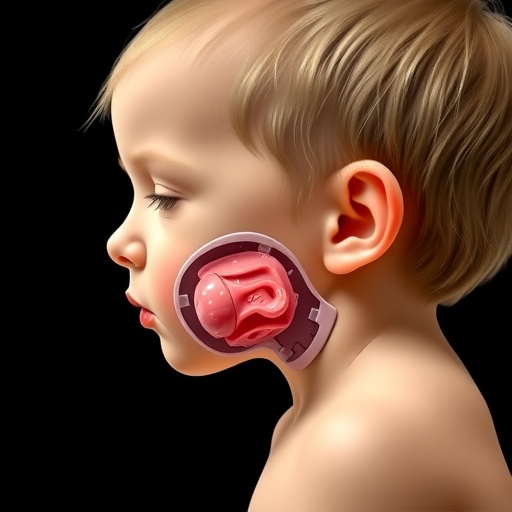The delicate architecture of the pediatric airway has long posed critical challenges to anesthesiologists and pediatricians alike, particularly when it comes to securing and maintaining a patent airway during sedation. In an innovative study recently published in World Journal of Pediatrics, researchers have offered compelling new insights into how lateral positioning affects upper airway morphology in children under the age of five while sedated. This investigation not only advances our anatomical understanding but also carries profound implications for clinical practice, potentially reshaping how airway management is approached in young, vulnerable patients.
The study meticulously examines the upper airway, a complex and dynamic structure comprising the nasal passages, pharynx, and larynx, all of which are highly susceptible to collapse or obstruction under sedation. Sedation is commonly required for various diagnostic and therapeutic procedures in pediatrics, yet maintaining airway patency during this state remains a clinical challenge. Traditional supine positioning, frequently employed during sedation, can exacerbate airway obstruction risks, prompting the scientific inquiry into how lateral positioning may mitigate these dangers and optimize respiratory parameters.
Using advanced imaging techniques, including three-dimensional reconstruction and magnetic resonance imaging (MRI), the researchers quantitatively assessed the morphometric changes in the upper airway that occur in sedated children aged five years or younger when positioned laterally as opposed to supine. These techniques provided an unprecedented level of anatomical detail, allowing for the examination of subtle dimensional variations and volumetric changes that influence airway patency. The findings illuminate that lateral positioning notably alters key anatomical dimensions, potentially reducing the risk of airway collapse.
.adsslot_RmzUVr3S7a{ width:728px !important; height:90px !important; }
@media (max-width:1199px) { .adsslot_RmzUVr3S7a{ width:468px !important; height:60px !important; } }
@media (max-width:767px) { .adsslot_RmzUVr3S7a{ width:320px !important; height:50px !important; } }
ADVERTISEMENT
One of the pivotal discoveries centers on the cross-sectional area of the upper airway. When children were placed in the lateral position, the researchers observed a statistically significant increase in the upper airway’s minimum cross-sectional area compared to the supine position. This incremental enlargement facilitates improved airflow and reduces airway resistance. From a physiological standpoint, the lateral position may thus serve as a natural adjunct to airway management, enhancing ventilation without the need for invasive interventions or pharmacological escalation.
Moreover, the study dives deep into the geometry of the upper airway, detailing how lateral positioning influences the shape and curvature of the oropharyngeal segment. The alteration in spatial configuration reduces collapsibility by redistributing soft tissue structures and attenuating gravitational effects that typically exacerbate airway obstruction in the supine posture. This nuanced understanding provides a mechanistic basis for the observed improvements in airway dimensions and function in lateral positions.
Critically, this research underscores the age-dependent variability inherent in pediatric airways. Young children possess anatomical and physiological traits distinct from older children and adults, such as relatively larger tonsils, a more compliant airway, and disproportionate soft tissue masses. Consequently, the airway’s propensity for collapse under sedation is heightened in this demographic. The study’s focus on children under five years delineates age-specific insights, recognizing that airway management protocols cannot simply extrapolate from adult data.
The clinical ramifications of these findings are far-reaching. Sedation carries inherent risks, with airway obstruction being one of the most feared complications. By demonstrating that simple lateral positioning can significantly improve airway morphology, this study suggests a potentially non-invasive, cost-effective strategy for minimizing sedation-related respiratory compromise in pediatric patients. This approach could be seamlessly integrated into procedural sedation protocols, thereby enhancing patient safety.
In addition to safety, the study highlights the potential for lateral positioning to reduce the need for airway adjuncts, such as oral or nasal airways, and even more invasive maneuvers like endotracheal intubation. This has particular relevance in settings with limited resources or where sedation is administered outside the traditional operating room environment, including radiology suites or outpatient clinics. Thus, lateral positioning may serve as a universally accessible intervention to optimize airway patency.
From an anesthetic management perspective, these findings are poised to influence guidelines and training paradigms. Educators may incorporate lateral positioning as a first-line consideration when managing sedation in young children, emphasizing its role not only in airway patency but also in oxygenation and ventilation efficiency. Furthermore, this research bolsters the impetus for multidisciplinary collaboration between anesthesiologists, pediatricians, radiologists, and respiratory therapists to ensure data-driven airway management strategies.
Equally significant is the study’s methodological rigor. It leverages a robust sample size with careful selection criteria and incorporates precise sedation protocols to minimize variability. The imaging was performed under standardized conditions, and data analysis employed sophisticated spatial modeling techniques. These methodological strengths lend credence and reproducibility to the outcomes, positioning this work as a cornerstone reference for future exploratory and interventional studies.
The research team also addresses potential limitations, noting that while lateral positioning demonstrates clear benefits for airway morphology, individual anatomical variance and the depth of sedation may modulate these effects. This caveat underscores the importance of clinical vigilance and the need for practitioners to tailor positioning strategies in conjunction with continuous monitoring, rather than adopting a one-size-fits-all approach.
Looking forward, the study posits several avenues for future exploration. Longitudinal research tracking airway dynamics with lateral positioning in various sedation depths and across different age brackets could deepen understanding. Additionally, integrating functional respiratory assessments such as polysomnography and capnography might elucidate the physiological correlates complementing morphological changes. This comprehensive assessment would holistically evaluate airway patency under sedation.
The evidence presented may also catalyze innovation in devices and supportive technologies designed to maintain optimal pediatric airway positioning. For example, novel positioning aids or beds that facilitate and sustain lateral decubitus postures without compromising access or safety could emerge from these insights. Such engineering advances would further embed lateral positioning into routine clinical practice with ergonomic precision.
Finally, the broader implications of this research resonate beyond sedation practices. The anatomical and physiological principles elucidated herein bear relevance to pediatric sleep medicine, particularly in understanding obstructive sleep apnea pathophysiology and management. The lateral position has been long recognized in adults with sleep apnea; this study extends that paradigm into pediatric sedation and airway maintenance, affirming the position’s therapeutic value across multiple domains.
In sum, this landmark work unravels crucial biomechanical and anatomical alterations induced by lateral positioning in the upper airway of sedated children under five, setting a new standard in airway management research. The confluence of technical imaging advancements and clinical applicability illuminates a pathway toward safer, more effective sedation practices that honor the unique vulnerabilities of young pediatric patients.
Subject of Research: Impact of lateral positioning on upper airway morphology in sedated children under five
Article Title: Impact of lateral positioning on upper airway morphology in sedated children under five
Article References:
Li, H., Jia, X., Ye, H. et al. Impact of lateral positioning on upper airway morphology in sedated children under five. World J Pediatr 21, 587–596 (2025). https://doi.org/10.1007/s12519-025-00910-w
Image Credits: AI Generated
DOI: June 2025
Tags: airway morphology in childrenairway obstruction risks in childrenclinical implications of airway researchinnovative studies in pediatric carelateral positioning in sedationMRI in pediatric studiesoptimizing respiratory parameters in sedationpediatric airway managementpediatric anesthesia techniquessedation challenges in pediatricsthree-dimensional imaging in medicineupper airway dynamics





